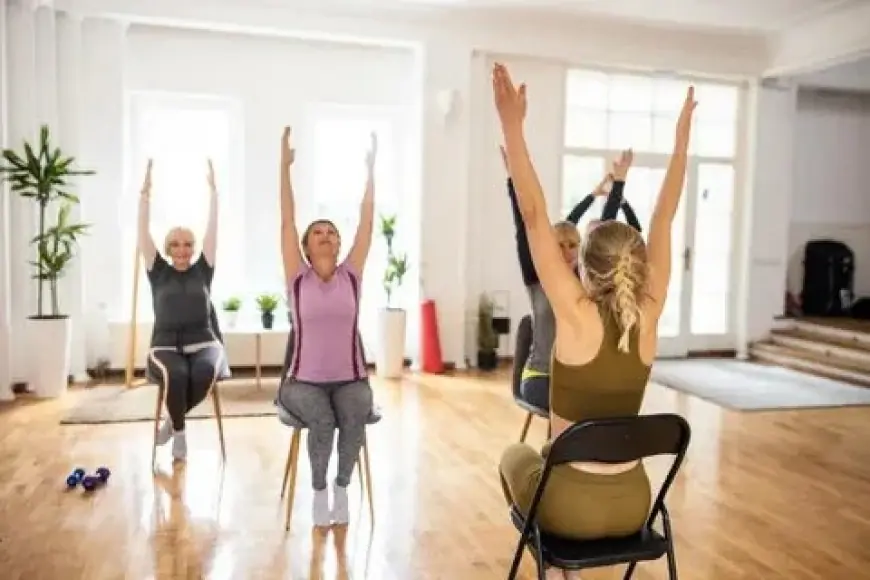From Power to Presence: The Diverse World of Yoga

Yoga, an ancient practice rooted in Indian philosophy, has evolved into a global phenomenon, offering a vast spectrum of physical, mental, and spiritual benefits. While many people associate yoga with a single, uniform style, the reality is that the practice encompasses a rich diversity of forms, each with its unique approach and benefits. From the dynamic and high-energy flows of power vinyasa yoga to the gentle and supportive poses of seated yoga for seniors, there is a style for every body, every age, and every goal. This article explores the contrasting yet complementary worlds of these two popular yoga forms, highlighting their distinct characteristics and the profound impact they can have on a person's well-being.
The Dynamic Flow of Power Vinyasa Yoga
Power vinyasa yoga is a modern, athletic style of yoga that has gained immense popularity for its physically demanding and mentally invigorating nature. The term "vinyasa" refers to the seamless, breath-synchronized movement that links one pose to the next. In a power vinyasa class, students flow through a continuous sequence of poses, building heat, strength, and stamina. This style is often fast-paced, incorporating challenging arm balances, inversions, and deep stretches.
The appeal of power vinyasa lies in its ability to provide a full-body workout. The constant movement elevates the heart rate, improving cardiovascular health. Holding poses for extended periods builds muscular strength and endurance, while the fluidity of the flow enhances flexibility and balance. Beyond the physical benefits, the rhythmic breathing and focused concentration required in power vinyasa can be a powerful form of moving meditation. The practice encourages a deep connection between the mind and body, helping to reduce stress and increase mental clarity. For those seeking a rigorous and transformative practice, power vinyasa offers a path to build not just a strong body, but also a resilient mind.
Seated Yoga for Seniors: A Gentle Approach to Wellness
On the other end of the spectrum is seated yoga for seniors, a practice designed with accessibility and safety in mind. This style is particularly beneficial for individuals with limited mobility, balance concerns, or those recovering from injuries. As the name suggests, the majority of the practice is performed while seated in a chair, which provides crucial support and stability. The chair allows participants to safely perform stretches, twists, and gentle strengthening exercises without the fear of falling.
The benefits of seated yoga are just as profound as those of more active styles, though they are achieved through a gentler means. The practice helps to improve flexibility in the joints and muscles, which is vital for maintaining independence and performing daily activities. Gentle movements and stretches can help relieve stiffness and joint pain often associated with conditions like arthritis. Furthermore, seated yoga promotes better circulation, reduces stress, and can improve posture. The focus on deep, mindful breathing in seated yoga classes has a calming effect on the nervous system, providing a sense of peace and relaxation. Instructors often incorporate props and modifications, making the practice highly adaptable to individual needs. For seniors, or anyone seeking a less strenuous entry into yoga, seated yoga offers a welcoming and effective way to experience the practice’s many health benefits.
Bridging the Gap: Finding Your Perfect Practice
While power vinyasa yoga and seated yoga for seniors may seem worlds apart, they are united by a common philosophy: using movement and breath to foster a deeper connection with oneself. Both styles emphasize mindfulness, awareness, and the importance of listening to one's body. A seasoned power vinyasa practitioner might seek a gentle, restorative practice on a day their body feels tired, and a senior who has built strength and confidence through chair yoga might eventually try a standing sequence. The journey of yoga is not about adhering to one rigid style, but rather about finding what works best for you at any given moment.
The provided URL highlights a specific "Express Chair Yoga" class, a testament to the growing demand for accessible yoga practices. The description of this class confirms that even a shorter, 45-minute session can effectively improve metabolism, strength, and flexibility while reducing joint strain—echoing the core benefits of seated yoga for seniors. This further reinforces the idea that effective yoga is not about the complexity of the poses, but about the quality of the movement and the intention behind it.
Conclusion
The world of yoga is a vast and welcoming one, with a practice for every person, regardless of their age, physical condition, or fitness level. The contrast between the vigorous demands of power vinyasa yoga and the supportive embrace of seated yoga for seniors beautifully illustrates the practice's versatility and adaptability. Whether you are seeking a sweat-inducing workout or a gentle path to increased mobility, yoga offers a solution. Ultimately, the best practice is the one that meets you where you are, fostering a sense of well-being, strength, and inner peace. By exploring the diverse landscape of yoga, individuals can discover a lifelong path to health and happiness.
What's Your Reaction?
 Like
0
Like
0
 Dislike
0
Dislike
0
 Love
0
Love
0
 Funny
0
Funny
0
 Angry
0
Angry
0
 Sad
0
Sad
0
 Wow
0
Wow
0


















































